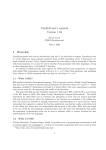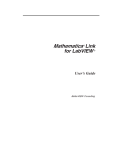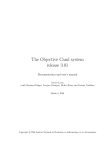Download Camlidl user`s manual Version 1.02 - The Caml language
Transcript
Camlidl user’s manual
Version 1.02
Xavier Leroy
INRIA Rocquencourt
July 30, 2001
1
Overview
Camlidl generates stub code for interfacing Caml with C (as described in chapter “Interfacing with
C” of the Objective Caml reference manual1 ) from an IDL description of the C functions to be
made available in Caml. Thus, Camlidl automates the most tedious task in interfacing C libraries
with Caml programs. It can also be used to interface Caml programs with other languages, as long
as those languages have a well-defined C interface.
In addition, Camlidl provides basic support for COM interfaces and components. It supports
both using COM components (usually written in C++ or C) from Caml programs, and packaging
Caml objects as COM components that can then be used from C++ or C.
1.1
What is IDL?
IDL stands for Interface Description Language. This is a generic term for a family of small languages
that have been developed to provide type specifications for libraries written in C and C++. Those
languages resembles C declarations (as found in C header files), with extra annotations to provide
more precise types for the arguments and results of the functions.
The particular IDL used by Camlidl is inspired by Microsoft’s IDL, which itself is an extension
of the IDL found in DCE (The Open Group’s Distributed Common Environment). The initial
motivation for those IDLs was to automate the generation of stub code for remote procedure
calls and network objects, where the arguments to the function are marshaled at the calling site,
then sent across the network or through interprocess communications to a server process, which
unmarshals the arguments, compute the function application, marshal the results, sends them back
to the calling site, where they are unmarshaled and returned to the caller. IDLs were also found
to be very useful for inter-language communications, since the same type information that guides
the generation of marshaling stubs can be used to generate stubs to convert between the data
representations of several languages.
1.2
What is COM?
COM is Microsoft’s Common Object Model. It provides a set of programming conventions as well
as system support for packaging C++ objects as executable components that can be used in other
1
http://caml.inria.fr/ocaml/htmlman/index.html
1
2
programs, either by dynamic linking of the component inside the program, or through interprocess
or internetwork communications between the program and a remote server. COM components
implement one or several interfaces, (similar to Caml object types or Java interfaces) identified by
unique 128-bit interface identifiers (IIDs). COM specifies a standard protocol for reference counting
of components, and for asking a component which interfaces it implements.
While the full range of COM services and third-party components is available only on Microsoft’s
Windows operating systems, the basic COM conventions can also be used on Unix and other
operating systems to exchange objects between Caml and C or C++. Of particular interest is the
encapsulation of Caml objects as COM components, which can then be used inside larger C or
C++ applications; those applications do not need to know anything about Caml: they just call the
component methods as if they were C++ methods or C functions, without knowing that they are
actually implemented in Caml.
For more information about COM, see for instance Inside COM by Dale Rogerson (Microsoft
Press), or the Microsoft developer Web site2 .
2
IDL syntax
This section describes the syntax of IDL files. IDL syntax is very close to that of C declarations,
with extra attributes between brackets adding information to the C types. The following example
should give the flavor of the syntax:
int f([in,string] char * msg);
This reads: “f is a function taking a character string as input and returning an int”.
2.1
Lexical conventions
Blanks. Space, newline, horizontal tabulation, carriage return, line feed and form feed are considered as blanks. Blanks are ignored, but they separate adjacent tokens.
Comments. Both C-style comments /* ... */ and Java-style comments // ... are supported.
C-style comments are introduced by /* and terminated by */. Java-style comments are introduced
by // and extend to the end of the line. Comments are treated as blank characters. Comments do
not occur inside string or character literals. Nested C-style comments are not supported.
Identifiers.
Identifiers have the same syntax as in C.
ident ::= (A . . . Z | a . . . z | _) {A . . . Z | a . . . z | 0 . . . 9 | _}
2
http://msdn.microsoft.com
3
Literals.
Integer literals, character literals and string literals have the same syntax as in C.
integer ::= [-] {0 . . . 9} [-] 0x {0 . . . 9 | a . . . f | A . . . F} [-] 0 {0 . . . 7}
character ::= ’ (regular-char | escape-char) ’
string ::= " {regular-char | escape-char} "
escape-char ::= \ (b | n | r | t)
| \ (0 . . . 7) [0 . . . 7] [0 . . . 7]
UUID. Unique identifiers are composed of 16 hexadecimal digits, in groups of 8, 4, 4, 4 and 12,
separated by dashes.
uuid ::= hex 8 - hex 4 - hex 4 - hex 4 - hex 4 hex 4 hex 4
hex ::= 0 . . . 9 | a . . . f | A . . . F
2.2
Limited expressions
Limited expressions are similar to C expressions, with the omission of assignment operators (=, +=,
etc). Operators have the same precedences and associativities as in C. They are listed below in
decreasing priority order.
lexpr ::=
|
|
|
|
|
|
|
|
|
|
|
|
|
|
|
|
|
ident
integer
character
true
false
string
sizeof ( type-expr )
( lexpr )
lexpr (. | ->) ident
( type-expr ) lexpr
(& | * | ! | ~ | - | +) lexpr
lexpr (* | / | %) lexpr
lexpr (+ | -) lexpr
lexpr (<< | >>) lexpr
lexpr (== | != | >= | <= | > | <)
lexpr (& | ^ | |) lexpr
lexpr (&& | ||) lexpr
lexpr ? lexpr : lexpr
Constant limited expressions, written const-lexpr below, can only reference identifiers that are
bound by the IDL const declaration.
4
2.3
Attributes
attributes ::= [ attribute {, attribute} ]
attribute ::=
|
|
|
|
ident
ident ( [lexpr] {, [lexpr]} )
ident ( uuid )
attribute *
* attribute
Attribute lists are written in brackets [...], and are always optional. Each attribute is identified
by a name, and may carry optional arguments. Starred attributes apply to the element type of a
pointer or array type, rather than to the pointer or array type itself. The following table summarizes
the recognized attributes and their arguments.
5
Attribute
abstract
bigarray
camlint
c2ml ( fun-name )
errorcheck ( fun-name )
errorcode
fortran
ignore
in
int_default ( camlint | nativeint | int32 | int64 )
int32
int64
length_is ( le 1 , le 2 , . . . )
long_default ( camlint | nativeint | int32 | int64 )
managed
ml2c ( fun-name )
mlname( label-name )
mltype(" caml-type-expr ")
nativeint
null_terminated
object
out
pointer_default ( ref | unique | ptr )
propget
propput
propputref
ptr
ref
set
size_is ( le 1 , le 2 , . . . )
string
switch_is ( le )
switch_type ( ty )
unique
uuid ( uuid )
2.4
Context where it can appear
typedef
array type
int or long integer type
typedef
typedef
typedef
array type with bigarray attribute
any pointer type
function parameter
interface
int or long integer type
int or long integer type
array type
interface
array type with bigarray attribute
typedef
struct field
typedef
int or long integer type
array of pointers
interface
function parameter
interface
function declaration
function declaration
function declaration
any pointer type
any pointer type
enum type
array type
character array or pointer
union type or pointer to union
union or pointer to union
any pointer, array, or bigarray type
interface
Types and declarators
The declaration of an identifier along with its type is as in C: a type specification comes first,
followed by the identifier possibly decorated with * and [...] to denote pointers and array types.
For instance, int x declares an identifier x of type int, while int (*x)[] declares an identifier x
6
that is a pointer to an array of integers.
type-spec ::=
|
|
|
|
|
|
|
|
|
|
|
|
|
|
[unsigned | signed] (int | short | long | char | hyper | long long | __int64)
byte
float
double
boolean
void
ident
wchar_t
handle_t
struct ident
union ident
enum ident
struct-decl
union-decl
enum-decl
declarator ::= {*} direct-declarator
direct-declarator ::= ident
| ( declarator )
| direct-declarator [ [const-lexpr] ]
2.5
Structures, unions and enumerations
struct-decl ::= struct [ident] { {field-decl} }
field-decl ::= attributes type-spec declarator {, declarator} ;
union-decl ::= union [ident] { {union-case} }
| union [ident] switch ( type-spec ident ) { {union-case} }
union-case ::= {case ident :}+ [field-decl] ; default : [field-decl] ;
enum-decl ::= enum [ident] { enum-case {, enum-case} [,] }
enum-case ::= ident [= const-lexpr]
IDL struct declarations are like those of C, with the addition of optional attributes on each
field. union declarations are also as in C, except that each case of an union must be labeled by
one or several case ident :. The first form of union declaration assumes that the discriminant of
the union is provided separately via a switch_is annotation on the union type, while the second
form encapsulates the discriminant along with the union itself (like in Pascal’s record case of
construct).
7
2.6
Function declarations
function-decl ::= attributes type-spec {*} ident ( params ) {quote ( ident , string )}
params ::= | void
| param {, param}
param ::= attributes type-spec declarator
Function declarations are like in ANSI C, with the addition of attributes on each parameter and
on the function itself. Parameters must be named. The optional quote statements following the
declaration are user-provided calling sequences and deallocation sequences that replaces the default
sequences in the camlidl-generated stub code for the function.
2.7
Constant definitions
constant-decl ::= const type-spec {*} ident = const-lexpr ;
A constant declaration associates a name to a limited expression. The limited expression can refer
to constant names declared earlier, but cannot refer to other kinds of identifiers.
2.8
IDL files
file ::= {decl}
decl ::=
|
|
|
|
|
|
|
|
|
|
|
|
|
function-decl ;
constant-decl ;
struct-decl ;
union-decl ;
enum-decl ;
typedef attributes type-spec declarator {, declarator} ;
attributes interface ident [: ident] { {decl} }
struct ident ;
union ident ;
union switch ( type-spec ident ) ;
attributes interface ident ;
import string ;
quote ( [ident ,] string )
cpp_quote ( string )
An IDL file is a sequence of IDL declarations. Declarations include function declarations, constant
declarations, type declarations (structs, unions, enums, as well as a C-style typedef declaration to
name a type expression), and interfaces.
An interface declaration gives a name and attributes to a collection of declarations. For interfaces with the object attribute, an optional super-interface can be provided, as in interface intf : super-intf .
The name of the interface can be used as a type name in the remainder of the file.
Forward declarations of structs, unions and interfaces are supported in the usual C manner, by
just giving the name of the struct, union or interface, but not its actual contents.
8
The import statement reads another IDL file and makes available its type and constant declarations in the remainder of the file. No code is generated for the functions and interfaces declared
in the imported file. The same file can be imported several times, but is read in only the first time.
The quote ( ident , str ) diversion copies the string str verbatim to one of the files generated
by the camlidl compiler. The ident determines the file where str is copied: it can be ml for the
Caml implementation file (.ml), mli for the Caml interface file (.mli), mlmli for both Caml files,
h for the C header file (.h), and c for the C source file containing the generated stub code (.c file).
For backward compatibility, cpp_quote ( str ) is recognized as synonymous for quote ( h , str ).
3
The Caml-IDL mapping
This section describes how IDL types, function declarations, and interfaces are mapped to Caml
types, functions and classes.
3.1
Base types
IDL type ty
byte, short
int, long with [camlint] attribute
int, long with [nativeint] attribute
int, long with [int32] attribute
int, long with [int64] attribute
hyper, long long, __int64
char
float, double
boolean
Caml type [[ty]]
int
int
nativeint
int32
int64
int64
char
float
bool
(For integer types, signed and unsigned variants of the same IDL integer type translate to the
same Caml type.)
Depending on the attributes, the int and long integer types are converted to one of the Caml
integer types int, nativeint, int32, or int64. Values of Caml type int32 are exactly 32-bit wide
and values of type int64 are exactly 64-bit wide on all platforms. Values of type nativeint have
the natural word size of the platform, and are large enough to accommodate any C int or long
int without loss of precision. Values of Caml type int have the natural word size of the platform
minus one bit of tag, hence the conversion from IDL types int and long loses the most significant
bit on 32-bit platforms. On 64-bit platforms, the conversion from int is exact, but the conversion
from long loses the most significant bit.
If no explicit integer attribute is given for an int or long type, the int_default or long_default
attribute of the enclosing interface, if any, determines the kind of the integer. If no int_default or
long_default attribute is in scope, the kind camlint is assumed, which maps IDL int and long
types to the Caml int type.
3.2
Pointers
The mapping of IDL pointer types depends on their kinds. Writing [[ty]] for the Caml type corresponding to the IDL type ty, we have:
9
[ref] ty *
[unique] ty *
[ptr] ty *
⇒
⇒
⇒
[[ty]]
[[ty]] option
[[ty]] Com.opaque
In other terms, IDL pointers of kind ref are ignored during the mapping: [ref] ty * is mapped
to the same Caml type as ty. A pointer p to a C value c = *p is translated to the Caml value
corresponding to c.
IDL pointers of kind unique are mapped to an option type. The option value is None for a
null pointer, and Some(v) for a non-null pointer to a C value c that translates to the ML value v.
IDL pointers of kind ptr are mapped to a Com.opaque type. This is an abstract type that
encapsulates the C pointer without attempting to convert it to an ML data structure.
IDL pointers of kind ignore denote struct fields and function parameters that need not be
exposed in the Caml code. Those pointers are simply set to null when converting from Caml to C,
and ignored when converting from C to Caml. They cannot occur elsewhere.
If no explicit pointer kind is given, the pointer_default attribute of the enclosing interface,
if any, determines the kind of the pointer. If no pointer_default attribute is in scope, the kind
unique is assumed.
3.3
Arrays
IDL arrays of characters that carry the [string] attribute are mapped to the Caml string type:
IDL type ty
[string] char []
[string] unsigned char []
[string] signed char []
[string] byte []
Caml type [[ty]]
string
string
string
string
Caml string values are translated to standard null-terminated C strings. Be careful about embedded
null characters in the Caml string, which will be recognized as end of string by C functions.
IDL arrays carrying the [bigarray] attribute are translated to Caml “big arrays”, as described
in the next section.
All other IDL arrays are translated to ML arrays:
ty []
⇒
[[ty]] array
For instance, double [] becomes float array. Consequently, multi-dimensional arrays are translated to Caml arrays of arrays. For instance, int [][] becomes int array array.
If the unique attribute is given, the IDL array is translated to an ML option type:
[string,unique] char [] ⇒ string option
[unique] ty []
⇒ [[ty]] array option
As in the case of pointers of kind unique, the option value is None for a null C pointer, and Some(v)
for a non-null C pointer to a C array that translates to the ML string or array v.
Conversion between a C array and an ML array proceed element by element. For the conversion
from C to ML, the number of elements of the ML array is determined as follows (in the order
presented):
10
• By the length_is attribute, if present.
• By the size_is attribute, if present.
• By the bound written in the array type, if any.
• By searching the first null element of the C array, if the null_terminated attribute is present.
For instance, C values of IDL type [length_is(n)] double[] are mapped to Caml float array
of n elements. C values of IDL type double[10] are mapped to Caml float array of 10 elements.
The length_is and size_is attributes take as argument one or several limited expressions.
Each expression applies to one dimension of the array. For instance, [size_is(*dimx, *dimy)]
double d[][] specifies a matrix of double whose first dimension has size *dimx and the second
has size *dimy.
3.4
Big arrays
IDL arrays of integers or floats that carry the [bigarray] attribute are mapped to one of the
Caml Bigarray types: Array1.t for one-dimensional arrays, Array2.t for 2-dimensional arrays,
Array3.t for 3-dimensional arrays, and Genarray.t for arrays of 4 dimensions or more.
If the [fortran] attribute is given, the big array is accessed from Caml using the Fortran
conventions (array indices start at 1; column-major memory layout). By default, the big array is
accessed from Caml using the C conventions (array indices start at 0; row-major memory layout).
If the [managed] attribute is given on a big array type that is result type or out parameter type
of a function, Caml assumes that the corresponding C array was allocated using malloc(), and
is not referenced anywhere else; then, the Caml garbage collector will free the C array when the
corresponding Caml big array becomes unreachable. By default, Caml assumes that result or out
C arrays are statically or permanently allocated, and keeps a pointer to them during conversion to
Caml big arrays, and does not free them when the Caml bigarrays become unreachable.
Finally, the [unique] attribute applies to bigarrays as to arrays, that is, it maps a null C
pointer to None, and a non-null C pointer p to Some(v) where v is the ML bigarray resulting from
the translation of p.
3.5
Structs
IDL structs are mapped to Caml record types. The names and types of the IDL struct fields
determine the names and types of the Caml record type:
struct s { ... ; ty i id i ; ... } becomes
type s = { ... ; id i : [[ty i ]] ; ... }
Example: struct s { int n; double d[4]; } becomes type s = {n: int; d: float array}.
Exceptions to this rule are as follows:
• Fields of the IDL struct that are pointers with the [ignore] attribute do not appear in
the Caml record type. Example: struct s { double x,y; [ignore] void * data; } becomes type struct_s = {x : float; y: float}. Those ignored pointer fields are set to
NULL when converting from a Caml record to a C struct.
11
• Integer fields of the IDL struct that appear in a length_is, size_is or switch_is attribute
of another field also do not appear in the Caml record type. (We call those fields dependent fields.) Example: struct s { int idx; int len; [size_is(len)] double d[]; }
is translated to the Caml record type type struct_s = {idx: int; d: float array}. The
value of len is recovered from the size of the Caml array d, and thus doesn’t need to be represented explicitly in the Caml record.
• If, after elimination of ignored pointer fields and dependent fields as described above, the
IDL struct has only one field ty id, we avoid creating a one-field Caml record type and
translate the IDL struct type directly to the Caml type [[ty]]. Example: struct s { int
len; [size_is(len)] double d[]; } is translated to the Caml type abbreviation type
struct_s = double array.
• The names of labels in the Caml record type can be changed by using the mlname attribute
on struct field declarations. For instance,
struct s { int n; [mlname(p)] int q; }
becomes type s = { n : int; p : int }
• The Caml type system makes it difficult to use two record types defined in the same module
and having some label names in common. Thus, if CamlIDL encounters two or more structs
having identically-named fields, it prefixes the Caml label names by the names of the structs
in order to distinguish them. For instance:
struct s1 { int x; int y; }
struct s2 { double x; double t; }
struct s3 { int z; }
becomes type s1 = { s1_x: int; s1_y: int }
and s2 = { s2_x: float; s2_t: float }
and s3 = { z: int }
The labels for s1 and s2 have been prefixed by s1_ and s2_ respectively, to avoid ambiguity
on the x label. However, the label z for s3 is not prefixed, since it is not used elsewhere.
The prefix added in front of multiply-defined labels is taken from the struct name, if any, and
otherwise from the name of the nearest enclosing struct, union or typedef. For instance:
typedef struct { int x; } t;
struct s4 { struct { int x; } z; };
becomes type t = { t_x: int }
and s4 = { z: struct_1 }
and struct_1 = { s4_x: int }
The “minimal prefixing” strategy described above is the default behavior of camlidl. If
the -prefix-all-labels option is given, all record labels are prefixed, whether they occur
several times or not. If the -keep-labels option is given, no automatic prefixing takes place;
the naming of record labels is left entirely under the user’s control, via mlname annotations.
12
3.6
Unions
IDL discriminated unions are translated to Caml sum types. Each case of the union corresponds
to a constructor of the sum type. The constructor is constant if the union case has no associated
field, otherwise has one argument corresponding to the union case field. If the union has a default
case, an extra constructor Default_unionname is added to the Caml sum type, carrying an int
argument (the value of the discriminating field), and possibly another argument corresponding to
the default field. Examples:
union u1 { case A: int x; case B: case C: double d; case D: ; }
becomes type u1 = A of int | B of float | C of float | D
union u2 { case A: int x; case B: double d; default: ; }
becomes type u2 = A of int | B of float | Default_u of int
union u3 { case A: int x; default: double d; }
becomes type u3 = A of int | Default_v of int * double
All IDL unions must be discriminated, either via the special syntax union name switch(int
discr). . . , or via the attribute switch_is(discr), where discr is a C l-value built from other parameters of the current function, or other fields of the current struct. Both the discriminant
and the case labels must be of an integer type. Unless a default case is given, the value of the
discriminant must be one of the cases of the union.
3.7
Enums
IDL enums are translated to Caml enumerated types (sum types with only constant constructors).
The names of the constructors are determined by the names of the enum labels. The values attached
to the enum labels are ignored. Example: enum e { A, B = 2, C = 4 } becomes type enum_e
= A | B | C.
The set attribute can be applied to a named enum to denote a bitfield obtained by logical “or”
of zero, one or several labels of the enum. The corresponding ML value is a list of zero, one or
several constructors of the Caml enumerated type. Consider for instance:
enum e { A = 1, B = 2, C = 4 };
typedef [set] enum e eset;
The Caml type eset is equal to enum_e list. The C integer 6 (= B | C) is translated to the ML
list [B; C]. The ML list [A; C] is translated to the C integer A | C, that is 5.
3.8
Type definitions
An IDL typedef statement is normally translated to a Caml type abbreviation. For instance,
typedef [string] char * str becomes type str = string.
If the abstract attribute is given, a Caml abstract type is generated instead of a type abbreviation, thus hinding from Caml the representation of the type in question. For instance, typedef
[abstract] void * handle becomes type handle. In this case, the IDL type in the typedef is
ignored.
If the mltype ( " caml-type-expr " ) attribute is given, the Caml type is made equal to
caml-type-expr. This is often used in conjunction with the ml2c and c2ml attributes to implement
13
custom translation of data structures between C and ML. For instance, typedef [mltype("int
list")] struct mylist_struct * mylist becomes type mylist = int list.
If the c2ml( funct-name ) andml2c(funct-name) attributes are given, the user-provided C
functions given as attributes will be called to perform Caml to C and C to Caml conversions for
values of the typedef-ed type, instead of using the camlidl-generated conversion functions. This
allows user-controlled translation of data structures. The prototypes of the conversion functions
must be
value c2ml(ty * input, camlidl_ctx ctx);
void ml2c(value input, ty * output, camlidl_ctx ctx);
where ty is the name of the type defined by typedef. In other terms, the c2ml function is passed
a reference to a ty and returns the corresponding Caml value, while the ml2c function is passed
a Caml value as first argument and stores the corresponding C value in the ty reference passed
as second argument. (The extra camlidl_ctx argument is for internal use by the generated stub
code; just ignore it.)
If the errorcheck( fn ) attribute is provided for the typedef ty, the error checking function fn
is called each time a function result of type ty is converted from C to Caml. The function can then
check the ty value for values indicating an error condition, and raise the appropriate exception.
If in addition the errorcode attribute is provided, the conversion from C to Caml is suppressed:
values of type ty are only passed to fn for error checking, then discarded.
3.9
Functions
IDL function declarations are translated to Caml functions. The parameters and results of the
Caml function are determined from those of the IDL function according to the following rules:
• First, dependent parameters (parameters that are size_is, length_is or switch_is of other
parameters) as well as parameters that are ignored pointers are removed.
• The remaining parameters are split into Caml function inputs and Caml function outputs.
Parameters with the [in] attribute are added to the inputs of the function. Parameters with
the [out] attribute are added to the outputs of the function. Parameters with the [in,out]
attribute are added both to the inputs and to the outputs of the function, unless they are
of type string or big array, in which case they are added to the inputs of the function only.
(The reason for this exception is that strings and big arrays are shared between Caml and C,
thus allowing true in,out behavior on the Caml function parameter, while other data types
are copied during Caml/C conversion, thus turning a C in,out parameter into a Caml copy
in, copy out parameter, that is, one parameter and one result.)
• The return value of the IDL function is added to the outputs of the Caml function (in first
position), unless it is of type void or of a type name that carries the errorcode attribute.
In the latter two cases, the return value of the IDL function is not transmitted to Caml.
• The Caml function is then given type in1 -> . . . -> inp -> out1 * . . . * outq where in1 . . . inp are
the types of its inputs and out1 . . . outq are the types of its outputs. If there are no inputs, a
unit parameter is added. If there are no outputs, a unit result is added.
14
Examples:
int f([in] double x, [in] double y)
f : float -> float -> int
Two double input, one int output
void g([in] int x)
g : int -> unit
One int input, no output
int h()
h : unit -> int
No input, one int result
void i([in] int x, [out] double * y)
i : int -> double
One int input, one double output (as an out parameter)
int j([in] int x, [out] double * y)
j : int -> int * double
One int input, one int output (in the result), one double output (as an out parameter)
void k([in,out,ref] int * x)
k : int -> int
The in,out parameter is both one int input and one int output.
HRESULT l([in] int x, [out] int * res1, [out] int * res2)
l : int -> int * int
HRESULT is a predefined type with the errorcode attribute, hence it is ignored. It
remains one int input and two int outputs (out parameters)
void m([in] int len, [in,size_is(len)] double d[])
m : float array -> int
len is a dependent parameter, hence is ignored. The only input is the double array
void n([in] int inputlen, [out] int * outputlen,
[in,out,size_is(inputlen),length_is(*outputlen)] double d[])
n : float array -> float array
The two parameters inputlen and outputlen are dependent, hence ignored. The
double array is both an input and an output.
void p([in] int dimx, [in] int dimy,
[in,out,bigarray,size_is(dimx,dimy)] double d[][])
p : (float, Bigarray.float64_elt, Bigarray.c_layout) Bigarray.Array2.t -> unit
The two parameters dimx and dimy are dependent (determined from the dimensions of
the big array argument), hence ignored. The two-dimensional array d, although marked
[in,out], is a big array, hence passed as an input that will be modified in place by the
C function p. The Caml function has no outputs.
15
Error checking: For every output that is of a named type with the errorcheck( fn ) attribute,
the error checking function fn is called after the C function returns. That function is assumed to
raise a Caml exception if it finds an output denoting an error.
Custom calling and deallocation sequences: The IDL declaration for a function can optionally specify a custom calling sequence and/or a custom deallocation sequence, via quote clauses
following the function declaration:
function-decl ::= attributes type-spec {*} ident ( params ) {quote ( ident , string )}
The general shape of a camlidl-generated stub function is as follows:
value caml_wrapper(value camlparam1, ..., value camlparamK)
/* Convert the function parameters from Caml to C */
param1 = ...;
...
paramN = ...;
/* Call the C function ’ident’ */
_res = ident(param1, ..., paramN);
/* Convert the function result and out parameters to Caml values */
camlres = ...;
/* Return result to Caml */
return camlres;
A quote(call, string ) clause causes the C statements in string to be inserted in the generated
stub code instead of the default calling sequence _res = ident(param1, ..., paramN). Thus,
the statements in string find the converted parameters in local variables that have the same names
as the parameters in the IDL declaration, and should leave the result of the function, if any, in the
local variable named _res.
A quote(dealloc, string ) clause causes the C statements in string to be inserted in the
generated stub code just before the stub function returns, hence after the conversion of the C
function results to Caml values. Again, the statements in string have access to the function result
in the local variable named _res, and to out parameters in local variables having the same names
as the parameters. Since the function results and out parameters have already been converted to
Caml values, the code in string can safely deallocate the data structures they point to.
Custom calling sequences are typically used to rearrange or combine function parameters, and
to perform extra error checks on the arguments and results. For instance, the Unix write system
call can be specified in IDL as follows:
int write([in] int fd,
[in,string,length_is(len)] char * data,
[in] int len,
[in] int ofs,
16
[in] int towrite)
quote(call,
" /* Validate the arguments */
if (ofs < 0 || ofs + towrite >= len) failwith(\"write\");
/* Perform the write */
_res = write(fd, data + ofs, towrite);
/* Validate the result */
if (_res == -1) failwith(\"write\"); ");
Custom deallocation sequences are useful to free data structures dynamically allocated and returned
by the C function. For instance, a C function f that returns a malloc-ed string can be specified in
IDL as follows:
[string] char * f([in] int x)
quote(dealloc, "free(_res); ");
If the string is returned as an out parameter instead, we would write:
void f ([in] int x, [out, string*] char ** str)
quote(dealloc, "free(*str); ");
3.10
Interfaces
IDL interfaces that do not have the object attribute are essentially ignored. That is, the declarations contained in the interface are processed as if they occurred at the top-level of the IDL
file. The pointer_default, int_default and long_default attributes to the interface can be
used to specify the default pointer kind and integer mappings for the declarations contained in the
interface. Other attributes, as well as the name of the super-interface if any, are ignored.
IDL interfaces having the object attribute specify COM-style object interfaces. The function
declarations contained in the interface specify the methods of the COM interface. Other kinds
of declarations (type declarations, import statements, etc) are treated as if they occurred at the
top-level of the IDL file. An optional super-interface can be given, in which case the COM interface
implements the methods of the super-interface in addition to those specified in the IDL interface.
Example:
[object, uuid(...)] interface IA { typedef int t; int f(int x); }
[object] interface IB : IA { import "foo.idl"; void g([string] char * s); }
This defines a type t and imports the file foo.idl as usual. In addition, two interfaces are declared:
IA, containing one method f from int to int, and IB, containing two methods, f from int to int
and g from string to unit.
The definition of an object interface i generates the following Caml definitions:
• An abstract type i identifying the interface. COM interfaces of type i are represented in Caml
with type i Com.interface.
• If a super-interface s is given, a conversion function s_of_i of type i Com.interface -> s
Com.interface.
17
• If the uuid(iid) attribute is given, a value iid_i of type i Com.iid holding the given interface
identifier.
• A Caml class i_class, with the same methods as the COM interface.
• A function use_i of type i Com.interface -> i_class, to transform a COM object into a
Caml object. This allows the methods of the COM object to be invoked from Caml.
• A function make_i of type #i_class -> i Com.interface, to transform a Caml object into
a COM object with interface i. This allows the methods of the Caml object to be invoked
from any COM client.
Example: in the IA and IB example above, the following Caml definitions are generated for IA:
type iA
val iid_iA : iA Com.iid
class iA_class : iA Com.interface -> object method f : int -> int end
val use_iA : iA Com.interface -> iA_class
val make_iA : #iA_class -> iA Com.interface
For IB, we get:
type iB
val iA_of_iB : iB Com.interface -> iA Com.interface
class iB_class :
iB Com.interface -> object inherit iA_class method g : string -> unit end
val use_iB : iB Com.interface -> iB_class
val make_iB : #iB_class -> iB Com.interface
Error handling in interfaces: Conventionally, methods of COM interfaces always return a
result of type HRESULT that says whether the method succeeded or failed, and in the latter case
returns an error code to its caller.
When calling an interface method from Caml, if the method returns an HRESULT denoting failure,
the exception Com.Error is raised with a message describing the error. Successful HRESULT return
values are ignored. To make them available to Caml, camlidl defines the types HRESULT_bool
and HRESULT_int. If those types are used as return types instead of HRESULT, failure results are
mapped to Com.Error exceptions as before, but successful results are mapped to the Caml types
bool and int respectively. (For HRESULT_bool, the S_OK result is mapped to true and other
successful results are mapped to false. For HRESULT_int, the low 16 bits of the result code are
returned as a Caml int.)
When calling a Caml method from a COM client, any exception that escapes the Caml method
is mapped back to a failure HRESULT. A textual description of the uncaught exception is saved using
SetLastError, and can be consulted by the COM client using GetLastError (this is the standard
convention for passing extended error information in COM).
If the IDL return type of the method is not one of the HRESULT types, any exception escaping
the Caml method aborts the whole program after printing a description of the exception. Hence,
programmers of Caml components should either use HRESULT as result type, or make very sure that
all exceptions are properly caught by the method.
18
4
Using camlidl
4.1
Overview
The camlidl stub generator is invoked as follows:
camlidl options file1.idl file2.idl ...
For each file f.idl given on the command line, camlidl generates the following files:
• A Caml interface file f.mli that defines the Caml view of the IDL file. It contains Caml
definitions for the types declared in the IDL file, as well as declarations for the functions and
the interfaces.
• A Caml implementation file f.ml that implements the f.mli file.
• A C source file f.c that contains the stub functions for converting between C and Caml data
representations.
• If the -header option is given, a C header file f.h containing C declarations for the types
declared in the IDL file.
The generated .ml and .c files must be compiled and linked with the remainder of the Caml
program.
4.2
Options
The following command-line options are recognized by camlidl.
-cpp
Pre-process the source IDL files with the C preprocessor. This option is set by default.
-D symbol=value
Define a preprocessor symbol. The option -Dsymbol=value is passed to the C preprocessor.
The value can be omitted, as in -D symbol, and defaults to 1.
-header
Generate a C header file f.h containing C declarations for the types and functions declared
in the IDL file f.c.
-I dir
Add the directory dir to the list of directories searched for .idl files, as given on the command
line or recursively loaded by import statements.
-keep-labels
Keep the Caml names of record labels as specified in the IDL file. Do not prefix them with
the name of the enclosing struct, even if they appear in several struct definitions.
-nocpp
Suppresses the pre-processing of source IDL files.
19
-no-include
By default, camlidl emits a #include "f.h" statement in the file f.c containing the generated C code. The f.h header file being included is either the one generated by camlidl
-header, or generated by another tool (such as Microsoft’s midl compiler) from the IDL
file, or hand-written. The f.h file is assumed to provide all C type declarations needed for
compiling the stub code.
The -no-include option suppresses the automatic inclusion of the f.h file. The IDL file
should then include the right header files and provide the right type declarations via quote
statements.
-prefix-all-labels
Prefix all Caml names of record labels with the name of the enclosing struct. The default is
to prefix only those labels that could cause ambiguity because they appear in several struct
definitions.
-prepro preprocessing-command
Set the command that is executed to pre-process the source IDL files. The default is the C
preprocessor.
4.3
The camlidldll script
Under Windows, a bash script called camlidldll is provided to automate the construction of a
DLL containing a COM component written in Caml.
The script camlidldll accepts essentially the same command-line arguments and options as the
ocamlc compiler. (It also accepts .tlb type library files on the command-line; see section 6.3, “Dispatch interfaces”, for more information on type libraries.) It produces a DLL file that encapsulates
the Caml and C object files given on the command line.
Use regsvr32 /s file.dll to record the components in the system registry once it is compiled
to a DLL.
5
Module Com: run-time library for COM components
type ’a interface
The type of COM components implementing interface ’a
type ’a iid
The type of the interface identifier for interface ’a
type clsid
The type of component identifiers
20
type ’a opaque
The type representing opaque pointers to values of type ’a. Opaque pointers are pointers
with attribute ptr in IDL files.
exception Error of int * string * string
Exception raised to report Com errors. The arguments are Error(errcode, who, what).
errcode is the Com error code (HRESULT code) with the high bit clear. who identifies the
function or method that raised the exception. what is a message explaining the cause of the
error.
val initialize : unit -> unit
Initialize the COM library. Must be called once before using any function in this module.
Com.initialize can be called several times, provided that Com.uninitialize is called an
equal number of times before the program exits.
val uninitialize : unit -> unit
Terminate the COM library.
val query_interface : ’a interface -> ’b iid -> ’b interface
Com.query_interface comp iid asks the component comp whether it supports the interface
identified by iid. If yes, it returns the corresponding interface of the component. If not, it
raises Com.Error.
type iUnknown
The type of the interface IUnknown, from which all other interfaces derive.
type iDispatch
The type of the interface IDispatch, from which all dispatch interfaces derive.
21
val iUnknown_of : ’a interface -> iUnknown interface
Return the IUnknown interface of the given component. This operation never fails, since all
components support the IUnknown interface.
val combine : ’a interface -> ’b interface -> ’a interface
Combine the interfaces of two components. Com.combine c1 c2 returns a component that
supports the union of the interfaces supported by c1 and c2. When queried for an interface,
the resulting component delegates its implementation to c1 if c1 implements that interface,
and otherwise delegates its implementation to c2.
val clsid : string -> clsid
Parse the string representation of a component identifier (hex8-hex4-hex4-hex4-hex12,
where hexN represents N hexadecimal digits).
val create_instance : clsid -> ’a iid -> ’a interface
Com.create_instance clsid iid creates an instance of the component identified by clsid,
and returns its iid interface. The implementation of the component is searched in the registry;
if the component is implemented in a DLL, the DLL is loaded in memory if necessary; if the
component is implemented in a separate server process, the server is started if necessary.
Raise Com.Error if the component clsid cannot be found, or if it does not support interface
iid.
type ’a component_factory =
{ create : unit -> ’a interface;
clsid : clsid;
friendly_name : string;
ver_ind_prog_id : string;
prog_id : string }
Informations required for registering a Caml implementation of a component. create is a
function that returns a fresh instance of the component. clsid is the component identifier.
friendly_name is a short description of the component (for information only). ver_ind_prog_id
and prog_id are symbolic names for the component. By convention, prog_id is ver_ind_prog_id
plus a version number at the end, i.e. ver_ind_prog_id is "MyCamlComponent" while prog_id
is "MyCamlComponent.3".
22
val register_factory : ’a component_factory -> unit
Register a Caml implementation of a component. Com.register_factory f stores the component factory f in the registry. Other programs can then create instances of the component
by calling CreateInstance from C and C++ or Com.create_instance from Caml.
type hRESULT_int = int
type hRESULT_bool = bool
type bSTR = string
The Caml types corresponding to the IDL types HRESULT_int, HRESULT_bool and BSTR,
respectively.
6
6.1
Hints on writing IDL files
Writing an IDL file for a C library
When writing an IDL file for a C library that doesn’t have an IDL interface already, the include
files for that library are a good starting point: just copy the relevant type and functin declarations
to the IDL file, then annotate them with IDL attributes to describe more precisely their actual
behavior. The documentation of the library must be read carefully to determine the mode of
function parameters (in, out, inout), the actual sizes of arrays, etc.
The type definitions in the IDL file need not correspond exactly with those in the include files.
Often, a cleaner Caml interface can be obtained by omitting irrelevant struct fields, or changing
their types. For instance, the Unix library functions for reading library entries may use the following
structure:
struct dirent {
long int d_ino;
__off_t d_off;
unsigned short int d_reclen;
unsigned char d_type;
char d_name[256];
};
Of those fields, only d_name and d_ino are of interest to the user; the other fields are internal
information for the library functions, are not specified in the POSIX specs, and therefore must not
be used. Thus, in the IDL file, you should declare:
struct dirent {
long int d_ino;
char d_name[256];
};
23
Thus, the Caml code will have type struct_dirent = {d_ino: int; d_name: string} as desired. However, the generated stub code, being compiled against the “true” definition of struct
dirent, will find those two fields at the correct offsets in the actual struct.
Special attention must be paid to integer fields or variables. By default, integer IDL types are
mapped to the Caml type int, which is convenient to use in Caml code, but loses one bit when
converting from a C long integer, and may lose one bit (on 32-bit platforms) when converting from
a C int integer. When the range of values represented by the C integer is small enough, this loss
is acceptable. Otherwise, you should use the attributes nativeint, int32 or int64 so that integer
IDL types are mapped to one of the Caml boxed integer types. (We recommend that you use int32
or int64 for integers that are specified as being exactly 32 bit wide or 64 bit wide, and nativeint
for unspecified int or long integers.)
Yet another possibility is to declare certain integer fields or variables as double in the IDL file,
so that they are represented by float in Caml, and all 32 bits of the integer are preserved in Caml.
For instance, the Unix function to get the current type is declared as
time_t time(time_t * t);
where time_t is usually defined as long. We can nonetheless pretend (in the IDL file) that time
returns a double:
double time() quote(" _res = time(NULL); ");
This way, time will have the Caml type unit -> float. Again, the stub code “knows” that time
actually returns an integer, and therefore will insert the right integer-float coercions.
6.2
Sharing IDL files between MIDL and CamlIDL
The Microsoft software development kit provides a number of IDL files describing various libraries
and components. In its current state, camlidl cannot exploit those files directly: they use many
(often poorly documented) Microsoft IDL features that are not implemented yet in camlidl; symmetrically, camlidl introduces several new annotations that are not recognized by Microsoft’s midl
compiler. So, significant editing work on the IDL files is required.
The C preprocessor can be used to alleviate the camlidl-midl incompatibilities: camlidl defines
the preprocessor symbol CAMLIDL when preprocessing its input files, while midl does not. Hence,
one can bracket incompatible definitions in #ifdef CAMLIDL ... #else ... #endif. Along these
lines, a C preprocessor header file, camlidlcompat.h, is provided: it uses #define to remove
camlidl-specific attributes when compiling with midl, and to remove midl-specific attributes when
compiling with camlidl. Thus, an IDL file compatible with both midl and camlidl would look
like this:
#include <camlidlcompat.h>
#ifndef CAMLIDL
import "unknwn.idl";
import "oaidl.idl";
#endif
import "mymodule.idl";
// imports specific to MIDL
// imports common to MIDL and CamlIDL
24
typedef [abstract,marshal_as(int)] void * ptr;
...
#ifndef CAMLIDL
[...] library MyTypeLib {
importlib("stdole32.tlb");
[...] coclass MyComponent { [default] interface IX; }
}
#endif
Notice that since camlidl doesn’t handle type libraries, the type library part of an midl file must
be enclosed in #ifndef CAMLIDL.
6.3
Dispatch interfaces and type libraries
A dispatch interface, in COM lingo, is an interface that supports dynamic, interpreted dispatch of
method interfaces. This form of interpreted dispatch is used by Visual Basic and other scripting
languages to perform calls to methods of COM components.
CamlIDL provides minimal support for dispatch interfaces. To equip a Caml component with
a dispatch interface (thus making it callable from Visual Basic), you need to do the following:
1. Use IDispatch instead of IUnknown as the super-interface of the component’s interfaces.
2. Write a type library for your component and compile it using midl. A type library is a runtime representation of the interfaces supported by an object. The midl compiler can generate
a type library from the IDL description of the component, enriched with some special-purpose
declarations (the library and coclass statements). Refer to the documentation of midl for
more information.
3. Pass the type library files (.tlb files) generated by midl as extra arguments to camlidldll
when generating the DLL for your Caml component.
7
Release notes
Here are some caveats and open issues that apply to the current release.
Deallocation of function results and out parameters: If a C function dynamically allocates
some of its outputs (either returned or stored in out parameters), its IDL declaration must contain
a quote(dealloc, string ) clause to properly free the space occupied by those outputs after they
have been converted to Caml. Otherwise, memory leaks will occur. (The only exception is results
and output parameters of type [bigarray,managed] ty[], where the Caml garbage collector takes
care of deallocation.)
This does not conform to the MIDL and COM specifications, which say that space for out
data structures must be allocated with CoTaskMemAlloc by the callee, and automatically freed
25
using CoTaskMemFree by the generated stub code. (The specs don’t say what happens with the
return value of the function.) However, there are many functions in Win32 (not to mention the
Unix world) that do not follow this convention, and return data structures (e.g. strings) that are
statically allocated, or require special deallocation functions. Hence, camlidl leaves deallocation
of outputs entirely under user control.
Allocation and deallocation of in,out parameters: For in,out parameters, the MIDL/COM
rules are that the caller (the stub code) should allocate the inputs, the callee should free them and
allocate again its outputs, and the caller should free the outputs. As explained above, camlidlgenerated stubs don’t automatically free the outputs. Worse, the inputs passed to the functions
are allocated partially on the stack and partially in the heap (using CoTaskMemAlloc), so the callee
may perform an incorrect free on a stack-allocated argument. The best thing to do is avoid in,out
parameters entirely, and split them into one in and one out parameter.
Reference-counting of COM interfaces: Caml finalized objects are used to call Release
automatically on COM interfaces that become unreachable. The reference counting of interfaces
passed as in and out parameters is correctly implemented. However, in,out parameters that are
interfaces are not correctly handled. Again, avoid in,out parameters.
COM support: The support for COM is currently quite small. COM components registered in
the system registry can be imported via Com.create_instance. Components written in Caml can
be exported as DLLs, but not yet as standalone servers. Preliminary support for dispatch interfaces
is available, however many of the data types used in the Automation framework are not supported
yet (e.g. SAFEARRAY).


































